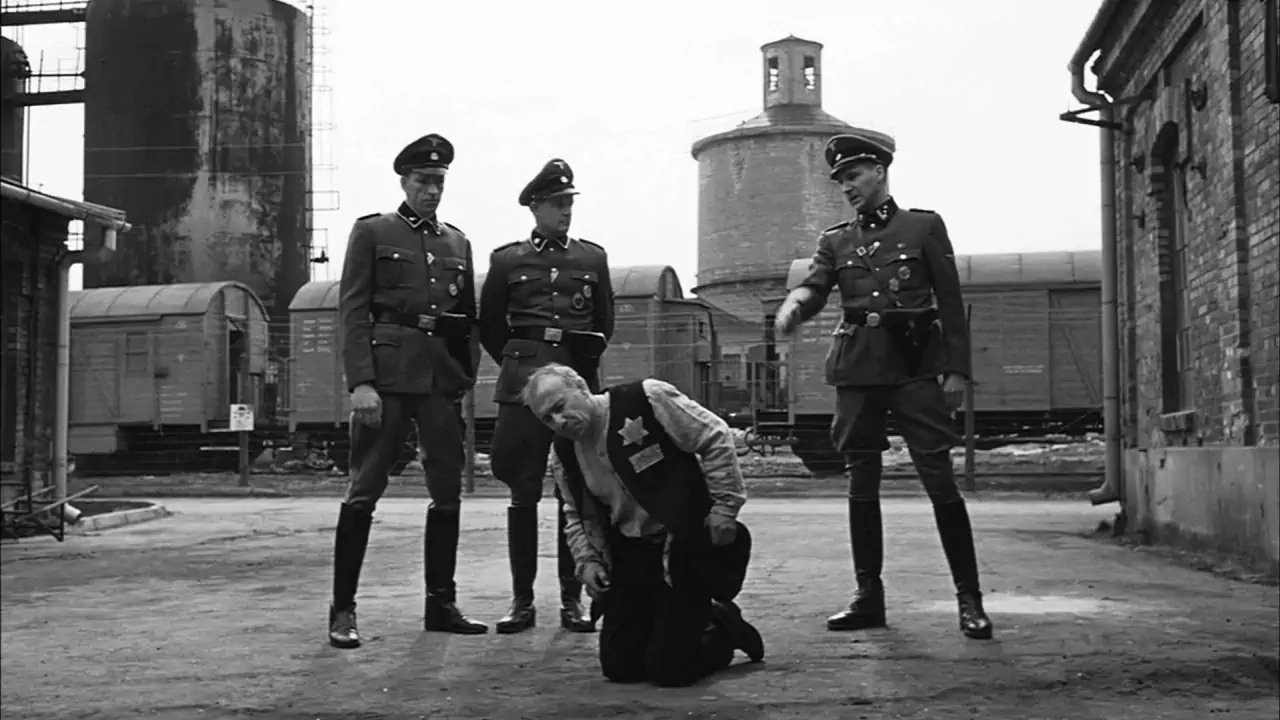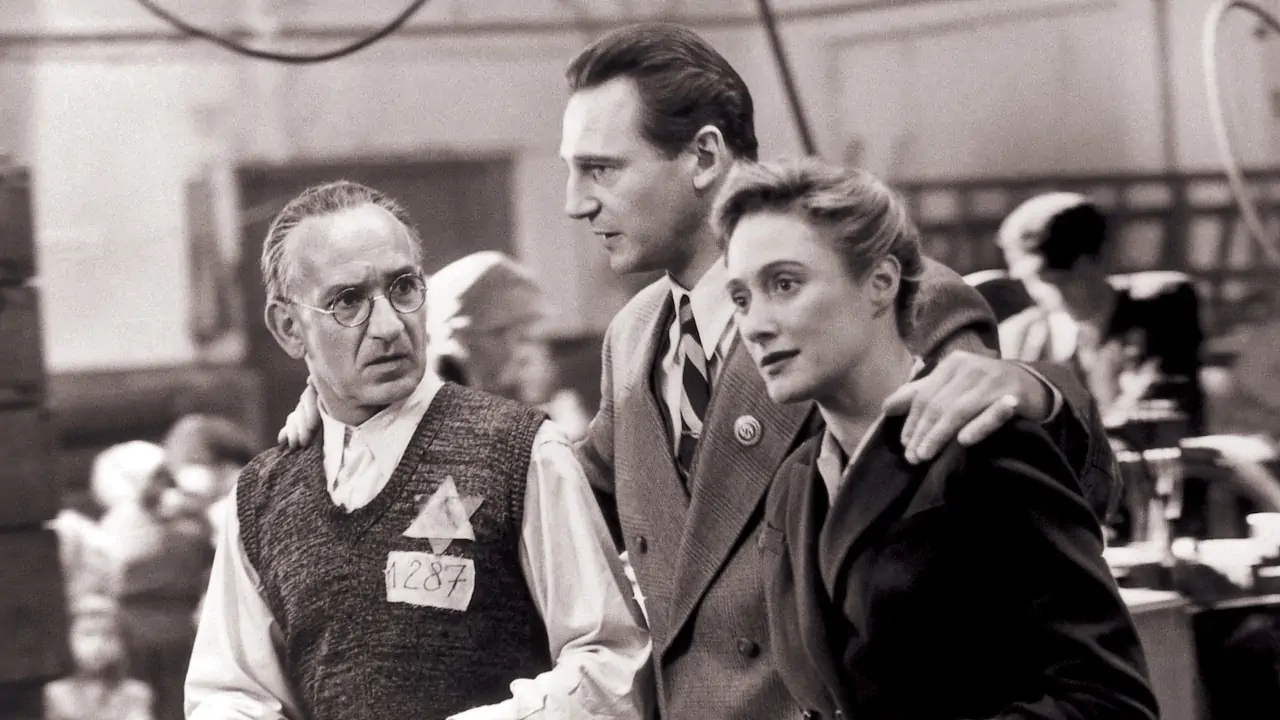
Welcome to our blog post on one of the most powerful and impactful films ever made – Schindler’s List. Directed by Steven Spielberg, this 1993 masterpiece takes us back to a dark chapter in history – World War II. With a stellar cast including Liam Neeson, Ben Kingsley, and Ralph Fiennes, it delves into the story of Oskar Schindler, a German businessman who saved over 1,000 Jewish lives during the Holocaust.

Prepare yourself for an emotional rollercoaster as we explore the themes and symbols that make this movie so profound. From hope and humanity amidst unimaginable horrors to acts of courage that defy all odds – Schindler’s List is more than just a film; it is an experience that will leave an indelible mark on your soul.
So grab some popcorn or maybe even a box of tissues because you’re about to embark on a journey like no other. Let’s dive into our review of Schindler’s List!
Summary of Schindler’s List
Schindler’s List, directed by Steven Spielberg, is a powerful and haunting film that tells the true story of Oskar Schindler, a German businessman who saved over 1,000 Jews during World War II. Set in Nazi-occupied Poland, the movie follows Schindler as he uses his connections and wealth to employ Jewish workers in his factory.
As the war intensifies and the atrocities committed against Jews increase, Schindler realizes the importance of saving lives. He takes great risks to protect his workers from deportation and certain death at concentration camps. The film showcases both the horrors of the Holocaust and moments of incredible humanity.
The performances in Schindler’s List are exceptional. Liam Neeson delivers a captivating portrayal of Oskar Schindler, showcasing his transformation from self-centered opportunist to compassionate hero. Ben Kingsley shines as Itzhak Stern, Schindler’s Jewish accountant who helps him navigate through bureaucracy.
Ralph Fiennes delivers an unforgettable performance as Amon Goeth, a sadistic SS officer with whom Schindler forms an uneasy alliance. Fiennes perfectly captures Goeth’s terrifying presence on screen.
Spielberg masterfully crafts each scene with precision and attention to detail. The black-and-white cinematography adds to the film’s stark realism while emphasizing its emotional impact. The use of color for specific objects throughout creates striking visual symbolism.
Schindler’s List is not an easy watch; it confronts viewers with some of humanity’s darkest moments. However, it also serves as a testament to courage and compassion in times of despair. This cinematic masterpiece will leave you deeply moved and reflecting on its themes long after you’ve watched it.
Themes and Symbols in Schindler’s List
Schindler’s List, directed by Steven Spielberg, is a masterpiece that delves deep into the darkest chapter of human history – World War II. The film explores various themes and utilizes powerful symbols to portray the horrors and complexities of this period.
One prominent theme in Schindler’s List is the power of redemption. Oskar Schindler, played by Liam Neeson, starts off as a selfish businessman exploiting Jewish labor for profit. However, as he witnesses the atrocities committed against Jews during the Holocaust, he undergoes a transformation and uses his wealth to save over a thousand lives. This theme highlights how even in times of immense darkness, humanity can still find ways to redeem itself.
Another significant theme is the contrast between good and evil. A key symbol that represents this dichotomy is the red coat worn by an innocent little girl amidst all the chaos and violence. The vibrant color stands out against Spielberg’s predominantly black-and-white cinematography, symbolizing hope and purity amidst despair.
Schindler’s List (1993) Trailer
The concept of loss also plays a crucial role in Schindler’s List. As we witness families being torn apart and lives shattered before our eyes, we are confronted with the profound tragedy faced by those affected by war. This theme serves as a reminder not only of what was lost during this time but also prompts us to reflect on how fragile peace can be.
One more notable theme explored in the film is individual responsibility. Through Oskar Schindler’s actions, we see how one person can make a difference when they choose to act ethically despite overwhelming pressures from society or personal gain.
Schindler’s List tackles these themes with sensitivity and authenticity while employing various symbolic elements throughout its narrative to enhance their impact on viewers’ emotions.
Schindler’s List Movie Review
Schindler’s List is a masterpiece that takes viewers on an emotional journey through one of the darkest periods in human history. Directed by Steven Spielberg, this film tells the incredible true story of Oskar Schindler, a German businessman who saved over 1,000 Jewish lives during World War II.
The film is brilliantly executed, with stellar performances from Liam Neeson as Schindler, Ben Kingsley as his loyal accountant Itzhak Stern, and Ralph Fiennes as the sadistic SS officer Amon Goeth. Each actor brings depth and complexity to their characters, making them feel incredibly real and relatable.
One of the most powerful aspects of Schindler’s List is its portrayal of the Holocaust. Spielberg doesn’t shy away from depicting the horrifying atrocities committed against Jews during this time. The black-and-white cinematography adds to the starkness and brutality of these scenes, creating a haunting visual experience for audiences.
Throughout the film, there are several recurring themes and symbols that add layers to its storytelling. The red coat worn by a young girl stands out in contrast to the monochrome backdrop, symbolizing innocence amidst darkness. Another important theme is redemption; we see how Oskar Schindler evolves from being solely focused on profit to risking everything he has to save lives.
Schindler’s List is not an easy watch – it confronts us with humanity at its worst. However, it also showcases acts of incredible bravery and compassion that give hope even in times of despair. This movie serves as a reminder that even in our darkest moments, there can be flickers of light.
In conclusion (not concluding), Schindler’s List remains an essential piece of cinema that should be watched by all. Its historical significance combined with Spielberg’s masterful storytelling make it a must-see for both cinephiles and those interested in learning more about World War II and the Holocaust — two pivotal events in human history.
Conclusion
Schindler’s List is a cinematic masterpiece that continues to resonate with audiences around the world. Steven Spielberg’s direction, coupled with powerful performances from Liam Neeson, Ben Kingsley, and Ralph Fiennes, brings Oskar Schindler’s incredible story to life on the big screen. This film serves as a stark reminder of the atrocities committed during World War II and highlights the capacity for humanity in even the most challenging circumstances.
Through its exploration of themes such as redemption, morality, and resilience, Schindler’s List forces viewers to confront their own values and actions. The use of symbolism throughout the film adds depth and enhances its impact on emotional levels. From the red coat that symbolizes innocence amidst darkness to the list itself representing hope and salvation, every element has been carefully crafted to evoke profound emotions.
Schindler’s List (1993) “I Didn’t Do Enough” Movie Clip
In this movie review, we have discussed how Schindler’s List captivates viewers through its compelling narrative and exceptional performances. It stands as a testament not only to Spielberg’s directorial prowess but also to his commitment in shedding light on important historical events.
Schindler’s List is more than just a movie; it is an experience that educates us about our past while encouraging us to reflect on our present actions. By portraying both acts of unspeakable evil and extraordinary heroism, this film reminds us of our collective responsibility towards preserving human dignity.
So if you haven’t seen Schindler’s List yet or are considering revisiting it after all these years – I highly recommend doing so. Prepare yourself for an emotional journey through one of history’s darkest periods but be prepared also for moments of hope that will undoubtedly inspire you long after watching it.
